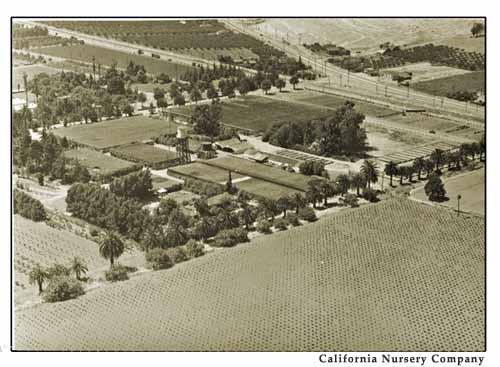|
California Nursery Historical Park George C.
Roeding Jr
(1902-1995) was born in
Fresno, California and grew up in the three story mansion
built by his grandfather Frederick Roeding centered in the
Fancher Creek Nursery property.
He worked at Fancher Creek
from as a youth but stated working during the summers at
California Nursery starting in 1914, before his father
bought the property in 1917.
Roeding Jr. was a quick
study and his father made him manager of the Niles Nursery
in 1925.
Roeding Jr. took over
control of California Nursery’s statewide network of
nurseries and retail outlets upon his father’s death in
1928.
(1) George C.
Roeding Jr. was a brilliant and outgoing salesman.
He saw the nursery market
changing with the growing California population and
redirected the business focus to retail sales rather when
wholesale sales to large orchards and nurseries.
While keeping a solid basis
of fruit trees in his catalogs, he expanded the ornamental
production with a particular emphasis on numerous varieties
of roses.
California
Nursery became a key producer of rose plants for the entire
United States, producing 1.5 million rose plants annually.
Indeed, whole sections of
the Nursery in Niles were devoted to rose production where
they were continually developing new varieties of roses.
(1) Like his
father before him, George Roeding Jr. work with the plant
scientists to obtain new varieties.
In 1940, he arranged to
work with Albert Etter (1872-1950), who like Luther Burbank,
was amazingly creative in this cross-polinization and
hybridization attempts to make new plant varieties.
One of Etter’s specialties
was apples.
He turned over 40 of his
apple varieties to Roeding to test in the CNC orchards.
Of the 40, Roeding Jr.
decided that seven were worth patenting and selling due to
their quality and flavor.
These seven
Etter apple varieties first
appeared in the 1944-45 California Nursery catalog. (2)
At first the nursery was mostly wholesale, then became a retail operation, ultimately becoming the largest firm of its kind west of the Rockies. Part of
California Nursery Company’s reputation had always been
built on high quality product.
George C.
Roeding Jr. continued and
increased this process, insisting that his trees and plants
be assessed not only on height, but graded on quality and
viability as well.
In the 1930s, he was able
to get a Grades and Standards Law for trees passed in
California, incorporating his methodology
(1)
Landscape
design projects grew under Roeding Jr., especially in the
1930s and 1940s.
Throughout this period, the
nursery had 8 design crews of 2-6 men each including a
separate office downtown Oakland.
CNC would design, provide
and install the plants for businesses and large mansions but
had predesigned layouts of designs for small homes to take
advantage of the ever increasing suburban market for home
gardens.
(1, 3)
Part of the
salesmanship acumen of Roeding Jr. was turning the
California Nursery Company in Niles into a destination point
for people to travel to.
To that end, various types
of display gardens were built especially near the office and
around the “Old Adobe” and ads were put out showing the
various activities
to
do while at the nursery.
The adobe was such a draw
that it was transformed into a tea house for visitors to
enjoy while making their purchases.
Geroge Jr. hired famed
landscape designers father and son team Johannes and
Frederic Reimers for this purpose.
The Reimers also redesigned
the nursery retail yard.
In
order to get large numbers of people to travel to the
nursery, an annual bulb show was created.
Starting
in the 1930s and continuing for decades, the bulb show took
place from mid-March to mid-April, displaying over 100,000
flowering bulbs each year.
The nursery was known far and wide
in the Bay Area and often became the destination for garden
lovers and horticulturists.
The event was extremely popular
and over 5000 people a weekend would visit Niles from all
over the Bay Area.
To accommodate the many
visitors, special trucks were equipped with long seats so
that people could take tours of the flower displays, gardens
and large nursery property and growing grounds.
THE OLD ADOBE AS
TRADEMARK
It
was during this period that the “Old Adobe” truly became the
trademark of Niles Nursery Company.
In Niles, the California
Nursery office building was changed to have a tile roof and
an adobe looking exterior which remains today.
Retail offices in other
cities also had an adobe look.
And
the adobe was not forgotten when the California Nursery
participated in the World Fair on Treasure Island in 1939 to
1940.
The Nursery not only
provided extensive landscaping at the fair but also had its
own display complete with a recreation of the hallmark
“adobe”.
LATER WAR EFFORTS
The Nursery
also had business with the US State Department especially in
the late 1940s and early 1950s with the development of the
United Nations starting postwar in San Francisco (4).
One of the biggest
contracts (and one of which the family is still proud) was
to provide large numbers of
flowering
dogwood trees as a gift from the United States
to the country of South
Korea.(1)
QUARRY BUSINESS
INVOLVMENT IN COMMUNITY
References
(1)
Roeding Bruce, Personal communication, April to June 2013
(2)
Etter website:
http://www.greenmantlenursery.com/fruit/etter-apples.htm
(3)
California Nursery Company layout designs
(4)
United Nations History
http://www.un.org/en/aboutun/history/
California Nursery (1971-present) |
|
|

